Review: LG V30
Oct 16, 2017, 10:15 AM by Eric M. Zeman
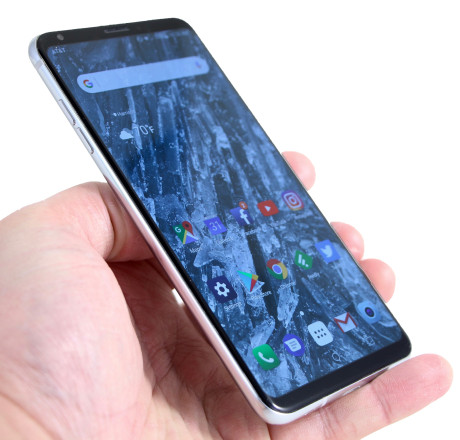
The LG V30 is a flagship handset that tries to move the needle forward with a stylish design, 18:9 display, and powerful camera features. This metal-and-glass Android slab is a gorgeous piece of hardware that has lots going for it. Unfortunately, several oddities hold it back from greatness. Here is Phone Scoop's in-depth look at the LG V30.
Hardware
Is It Your Type?
The V30 from LG is a classy powerhouse. With its refined design, gorgeous display, incredible camera, top specs, and flexible software, the V30 should appeal to those who demand the absolute most from their handset.
Hardware
It's practically perfect. Practically. The V30 is a stunning slab from LG, a luscious combination of metal and glass that surpasses anything we've seen before from the Korean phone maker. It is slim, attractive, and simply amazing.
To start, the V30 does away with the V20 and V10's most significant hardware feature: the Second Display. The V30's predecessors both offered a small, secondary screen that sat atop the front surface. It offered shortcuts to some functions, as well as additional tools in apps such as the camera. The Second Display is gone, replaced by a software equivalent, and the V30 is better for it.
The V30 doesn't have quite the curvy personality of Samsung's Galaxy S8, but it's close. The V30 takes the blockier shape of the LG G6 and smoothes out the edges. It's almost as though LG smooshed the G6 to create the V30, which is thinner, wider, and taller than the G6. Rounded glass covers the front and rear sides of the V30 and is held in place by a smooth metal frame. I really like the shape and feel of the frame. It may lack fancy chamfers, but the aluminum is polished to a nice shine. The phone comes in silver or black. Both look slick. There's no doubt in my mind this is LG's finest hardware.
The V30 is a fairly big phone, though it stops well short of being the biggest. It's definitely smaller than the Note8, iPhone 8 Plus, or Pixel 2 XL. LG did a commendable job keeping the footprint in check despite the huge 6-inch screen. The phone is under 6 inches tall and under 3 inches wide, which helps with hand fit. Those with the smallest hands may find it is still a bit too large, but most people should find the phone comfortable to hold and use. The slim profile and smooth edges allow the V30 to slip into nearly any pocket with no problem.
Build quality and materials are top notch. The aluminum frame wraps all the way around the exterior and creates a sturdy base for the glass panels. The glass feels excellent. The smooth panels are curved slightly where they join the metal frame. There are no gaps in the joint between the metal and glass, which is tight all the way around. Phones with glass on the front and back are surely delicate, but at least it's strong Gorilla Glass 5.
My one complaint is probably the weight. The phone weighs in a 5.57 ounces and it actually feels too light. It detracts just a bit from the perceived quality of the handset. The V30 would give me more confidence were it a little heavier. It almost feels like a toy. Phones such as the iPhone 8 Plus and Note8 are much heavier, and it actually helps with perceived quality. The actual quality of the V30 is great.
Few phones have as high a screen-to-bezel ratio as the V30. In other words, the face is all screen; LG practically eliminated the bezels entirely. I'm stunned by how LG managed to squeeze the earpiece speaker and user-facing camera above the screen. There are no hardware buttons on the phone's face, as the V30 relies on software controls. If you want maximum screen and minimum bezel, the V30 delivers.
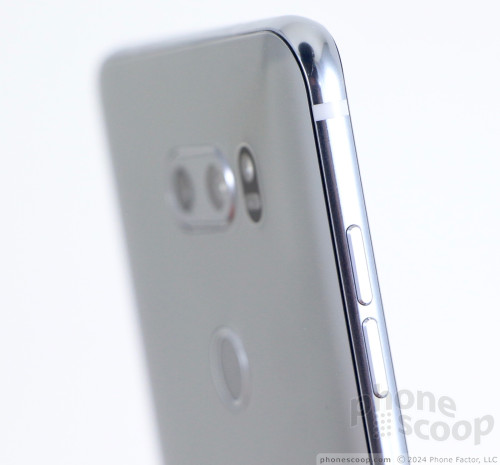
LG separated the volume toggle into two buttons, which are perched high on the phone's left edge. The keys have good profiles and excellent travel and feedback. The buttons are high quality. The down volume key will open the camera with a quick double press if you wish. The combined SIM/memory card tray is tucked into the right edge. I had no trouble using it with the included SIM tool. You'll find a 3.5mm headphone jack on the top edge (something fewer phones offer these days), and the USB-C port on the bottom.
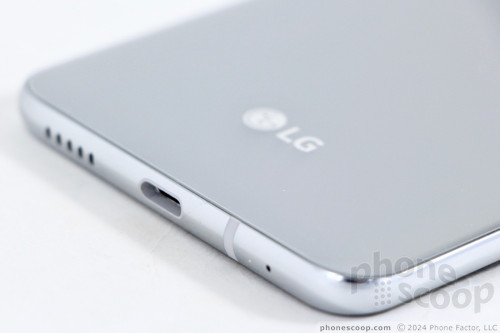
Smooth glass stretches across the entire rear panel of the phone. The V30 features a fingerprint/screen lock button on the rear panel. It's positioned well, about three-quarters of the way up. I had no trouble finding or using it, though I wish it were indented just a bit. The dual camera module protrudes just a bit.
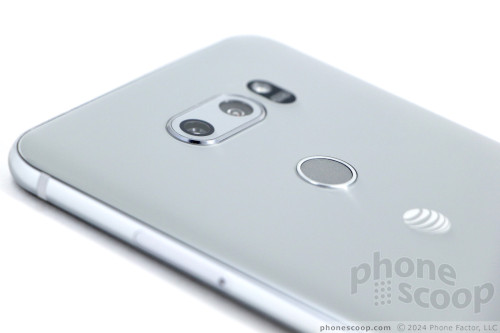
The V30 is waterproof thanks to an IP68 rating for water and dust ingress. It can sit in up to 1.5 meters of water for up to 30 minutes. That means it won't die a watery death if you drop it in the pool or sink. It can handle sweat and rain no problem. With that said, the phone is pretty much the opposite of rugged. The twin glass panels may be made of Gorilla Glass 5, but I would treat the phone tenderly. You'd be wise to find a case for the V30.
LG did an excellent job with the V30 design. It impresses all the way around.

Screen
The LG V30 makes use of an OLED display, which is rare (but not unheard-of) for the company. OLED displays reproduce perfect blacks, offer a wider color array, and have a faster response rate than LCDs (which is important for virtual reality.) The quad-HD+ resolution is excellent and the 2:1 aspect ratio feels modern. It's a fantastic screen.

I have only superlatives to heap on the V30's display. The pixel density means everything on the screen is smooth and free of ragged edges. The contrast and color are superb. The phone supports HDR video playback and I tested in with some Netflix content. It's about the best video experience possible on a modern handset. Brightness is very good. I was able to use the phone indoors and out with no problem.
Viewing angles aren't the best. I noticed a significant blue shift and brightness drop when tilting the phone side-to-side.
Like other flagships, LG provides plenty of advanced controls for the V30. For example, you can change the resolution if you want. Dropping the display from quad HD+ (2,880 x 1,440) to Full HD+ (2,160 x 1,080) will have an immediate positive impact on battery life. You can also manage app scaling (to improve compatibility with apps designed for 16:9 displays), screen color, and comfort view for late-night viewing.
Signal
LG has a half-dozen different versions of the V30 for various carriers and markets. The phone is among the first to ship with support for Gigabit LTE, though actually finding such service depends on carrier support. I tested the AT&T model and came away impressed.
The phone handily latched onto AT&T's 4G network and remained there throughout testing. Data speeds were robust and reached some of the quickest I've seen from AT&T. In real world terms, the V30 was able to stream high-quality video via YouTube and music via Spotify with no trouble at all. I saw little to no buffering and didn't experience any dropouts or pauses. The V30 is a fine data phone.
As for making phone calls, the handset was able to connect calls on the first dial each time. The phone kept calls connected over miles of highway driving with no effort.
If you're a T-Mobile customer, it's worth noting that the T-Mobile variant of the V30 supports LTE Band 66 and Band 71. Band 71 should provide a significant boost to coverage in rural areas.
Sound
Call volume left me slightly underwhelmed. The V30 delivers clean audio through the earpiece. Voices come through clear and with a warm tone. I was pleased with clarity and quality, but the V30 lacks audio power big time. Noisy spaces such as coffee shops or moving cars make calls through the V30 almost impossible to hear.
These issues carry over to the speakerphone. Clarity is just fine, even with the volume cranked all the way up, but the max volume doesn't deliver the punch I want. You can handle speakerphone calls easily in an office with the door closed, but those calls become much more difficult to hear if there's lot of ambient noise.
Accordingly, the ringers and alerts weren't as loud as I wanted. Walking around NYC, I had a hard time hearing the ringtones even when the volume was set up all the way. At least the vibrate alert, which is fully customizable, is quite good.
If you want to listen to music directly on the phone, you have to rely on the single bottom-firing speaker. As with speakerphone calls and ringers, it just doesn't deliver enough volume to impress much.
The V30 does include a quad DAC for high-quality listening, but this requires wired headphones used with the V30's headphone jack. I tested wired music quality and it's certainly impressive if you have good wired headphones. The quad DAC controls are only available when headphones are plugged into the phone.
Battery
The V30 packs a 3,300 mAh battery, which should be enough to deliver a full day of battery life and yet somehow it isn't. With the display set to the full resolution, the V30 just barely crawled its way from breakfast to bedtime. It was down to 10% most nights with just average usage throughout the day. On days when I spent a lot of time taking pictures, or using Maps for navigation, the battery was more apt to konk out around 9 or 10. Downgrading the resolution provides an immediate boost in battery life. I suggest you keep the resolution set to full HD+ except for when you're actively using VR. I was able to coax the phone from breakfast to bedtime with much more power to spare >30% with the resolution dialed bad to HD+.
LG gave the V30 extra tools to help manage battery life. In addition to the standard Android power saver mode, the V30 also has a setting that specifically reduces the processor power given to games.
The V30 supports Quick Charge 3.0 through its USB-C port. Thanks to the included fast charger, the V30 will power up quickly when needed. It also supports both major wireless charging standards, which means it is compatible with most wireless charging pads. I tested it on a Qi-based pad and it worked fine.
Bluetooth, GPS, NFC, WiFi
The V30's ancillary radios all worked very well. Bluetooth was a cinch to use and the NFC radio helped me pair the V30 with a wide array of Bluetooth accessories. I used the V30 for several calls via my car's hands-free system and they sounded very good (though quiet). Music had a rich sound when passed through a good Bluetooth speaker.
You can use the NFC radio for mobile payments via Google's Android Pay service. I found it worked well.
Google Maps and the V30's GPS radio were fine companions. The phone located me within seconds and was accurate to about 15 feet. That's excellent. Real-time navigation between points worked flawlessly.
The WiFi was particularly quick.
Software
Lock Screen
The V30 includes an Always On Display that shows the time, date, and battery life in white on the black screen. Incoming notifications, such as email, SMS, or Facebook, will cover up the clock for a split second before lining up next to the battery meter. This way you can always see what unread notifications await within. LG's version of this feature works well.
Lock Screen

You can customize the lock screen a bit. For example, you can set which shortcuts appear at the bottom, as well as where the clock appears on the screen. You can also adjust the swiping animation and choose whether or not to display the weather.
The V30 includes LG's KnockOn and Knock Code. Double-tap the display to wake the lock screen. This is most helpful when the phone is sitting on a table or desk. KnockCode is an optional security tool that unlocks the phone through a custom pattern of taps on the screen. I'm not sure it's necessary, given the V30's fingerprint sensor, but at least you have more than one way to wake the screen.
The V30's fingerprint reader is quick and reliable. It takes only a few moments to set up several fingerprints and I found the reader was consistently the fastest way to unlock the phone. Beyond unlocking the phone, the fingerprint reader can be used to secure individual photo galleries and QuickMemo files, but not apps or folders.
The V30 also includes facial recognition for unlocking the phone. The tool is fairly easy to set up, though LG warns it is not as secure as a fingerprint or password. Using the software, you can record your face a single time, or multiple times to improve accuracy and security. If you plan to use the facial recognition feature as your main lock, you'll notice the phone wakes up and unlocks very quickly when you raise the phone and look at it straight on. Sometimes it takes a second, but most of the time it's swifter. Facial recognition does not work very well in low-light, and won't function at all in the dark at all.
Home Screen
The V30 ships with Android 7.1 Nougat and a lot of software from LG.
Home Screen

You can select one of three different home screen arrangements. Out of the box the default home screen doesn't include the app drawer. This means all the apps are bundled together in folders on the home screens. You may elect to choose a different home screen experience that includes the app drawer (literally called Launcher + App Drawer). The third home screen option is EasyHome, which dumbs down the interface for novice users.
The V30 allows you to switch up wallpapers and other behaviors with ease. I like that apps can be arranged in various grid configurations (4x4, 4x5, 5x5) to allow for more effective use of the screen's real estate, and, using menu options, you can elect to hide apps you know you won't use often, as well as bring them back when needed. You can control behaviors such as fonts, font size, button arrangement, screen effects, and so on.
LG didn't mess with Android's Quick Settings panel too much. It includes five toggles across the top, as well as a slide to control screen brightness. You can customize which toggles appear in the Quick Settings screen and swipe the toggles to see more. The panel also allows you to access, act on, and dismiss notifications.
The main settings tools are broken down into several tabs by default, but you can adjust it so they appear on a single screen. It's rather dense and not that easy to use.
LG's Smart Bulletin is aboard, which becomes the left-most homescreen and provides quick access to certain data sets, such as LG Health, your calendar, and action items. The tool is inactive when you first boot the phone, but you can choose to turn it on if you wish.
Android's split-screen multitasking benefits from the screen's extra space.
The V30 ships with Qualcomm's Snapdragon 835 processor, the company's most advanced chip in 2017, with a reasonable 4 GB of RAM. There must be a bug in LG's code somewhere, because the V30 experiences some crazy screen response lag at times. Most apps run crazy fast, but every so often the screen simply won't respond to touch input, or it responds very slowly. Hopefully this is something LG can clean up quickly. Games ran smoothly and VR content presented no trouble whatsoever.
Floating Bar
LG didn't want to ignore the V series' legacy completely, so even though the V30 dropped the Second Display it includes a faux version called the Floating Bar. The Floating Bar is optional and is turned off by default.
Floating Bar
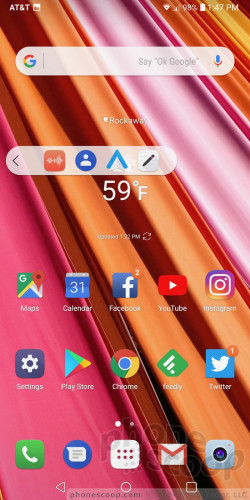
The Floating Bar supports up to four different sets of controls: shortcuts, screen capture, music player, and contacts.
The Floating Bar is accessible from either the right edge of the left edge of the V30. It appears as a small arrow in a half circle along the screen's border. I like that it comes and goes whenever you want. The Floating Bar reminds me a bit of Samsung's Edge Screen tool on Galaxy handsets. I think it's more useful than the dedicated Second Screen.
Camera
The V30 doesn't have a physical camera button, but you can launch the camera from the lock screen or with a quick double press of the volume-down button.
Where Apple and Samsung offer one standard lens and one telephoto lens, the LG V30 offers one standard lens and one wide-angle lens. The V30 allows you to zoom seamlessly from one camera to the other.
The camera interface is a really busy place. Starting from far left, a batch of options runs down the left side of the main screen and includes flash controls, user-facing camera, film effects, shooting modes, and settings. None of these can be customized.
There's a decent selection of shooting modes, including auto, Cine video, snap movie, popout, manual photo, manual video, match shot, slow-mo, time-lapse, 360 panorama, regular panorama, and more.
The big addition for the V30 is Cine video. This mode gives you 15 Hollywood-style filters for capturing video. Each filter has a distinct look and feel, helping videos stand out. For example, Noir is very 1930s detective-y, while scenery is better for landscapes, and summer blockbuster is great for outdoor action. You can adjust the strength of the effects. You can add the video filters at will while capturing video, and mix and match styles when editing the results later.
The other tool built into cine video is smooth zooming. Zooming with video cameras can often be a herky-jerky affair. With Point Zoom enabled, you select something in the viewfinder and tap the slider tool. The V30 will then smoothly zoom in on that subject, and you can control the speed. It's far more professional-looking than randomly dragging the slider tool. Neat stuff.
Pop-out mode creates a picture-within-a-picture effect. In other words, you have a smaller box in the middle of the frame with the subject, and larger box around the outside to which you can add effects (blur, fisheye distortion, etc.) to make the central image pop.
The multiview mode lets you shoot pictures with both rear cameras and the front camera at the same time so you can include yourself in a three-panel montage. There are several different panel configurations and you can arrange them however you wish.
The snap movie mode lets you assemble video clips into a 60-second story. You can shoot with 1, 2, or 3 panels in a variety of configurations. A quick tap of the shutter button records a 3-second video segment. You can piece together up to 20 of the 3-second clips, or press-and-hold the shutter button to record longer clips up to 60 seconds long. It takes some practice to use effectively.
Manual mode is for knowledgeable users who want to be creative. As the name implies, you have full control over everything: white balance, focus, brightness, ISO, and shutter speed. Shutter speed can be set as long as 30 seconds, (for dramatic and/or creative night shots.) You can also set the auto-exposure to lock. Each option has its own slider that lets you, for example, alter the focal point between close and far. As you do this, the screen changes to provide a preview of how the resulting image might look. It gives you some neat insight into how each individual part of the exposure process may affect the final result.
Manual mode for video is essentially the same thing, but it gives you far more control than most phones. You have several hi-fi audio controls, as well as control over frame rate, bit rate, and LUT. If you don't know what LUT means, then manual video mode probably isn't for you. These controls are intended for serious video pros. You can also save video to Cine Log format, which is like RAW mode for video. If you are a pro, be careful to dig into the full manual settings menu each time you shoot; it's too easy to accidentally shoot in a lower-quality mode than you might intend.
HDR is buried in the settings menu. You can set it to on, auto, or off.
Even though the V30 has two cameras, it doesn't include a bokeh or portrait mode. That's totally odd.
The user-facing camera includes a number of its own tools, including a screen flash, smile capture, gesture shot (make a fist to start a photo timer), and beautification filters.
The V30's camera software is extraordinarily quick to focus and snap photos. It's a powerful app that performs well. It could be a little simpler.
Photos/Video
The V30's twin cameras are on par with those we saw in the G6, but don't quite live up to the Note8 and iPhone 8 Plus. The standard view lens has a 16-megapixel sensor and an aperture of f/1.6 (the lowest ever for a phone, which should make it great for low light.) The wide-angle lens has a 13-megapixel sensor an aperture of f/1.9. Other features include optical image stabilization (on the standard lens), tracking focus, and zero shutter lag image capture.

After using the V30 for a week I'm mostly impressed with the results, though they are a bit uneven. The V30 was able to balance high-contrast scenes thanks to the auto HDR function. It does a fine job with focus, exposure, and white balance.The images I took around my home and of my kids were great. The one major issue is low-light photography. Both pictures and videos shot in dark environments are destroyed by grain and noise. The exposures are decent, but whatever LG is doing with its software leaves the results besotted with horrifying amounts of grain. Hopefully this is something LG can fix with software.
The 5-megapixel selfie camera shoots at a wide angle (90 degrees), but you can toggle a more narrow view of 75 degrees if you want. The front camera has a beautification tool, a lighting adjustment tool, and a lot of filters. I was pleased with the results. It's a good option for taking self-portraits for sharing across social networks.
The V30 lets you capture video from 720p through 4K resolutions at a variety of frame rates. Like the G6, the V30 defaults to 1080p HD in LG's 18:9 aspect ratio. This means the video you shoot on the phone will fill the phone's screen, but won't quite fill today's 16:9 screens. I thought the footage was quite good. As noted, dark environments lead to grainy results. Otherwise, the results are on par with today's flagships.
I worry about the low-light performance, but I think most people can leave the dedicated camera at home and use the V30 for nearly everything.
AT&T Stuff
AT&T continues to be a top offender when it comes to bloatware. The V30 is crammed full of junk apps, particularly the AT&T-branded stuff which is pushy about being selected as the default. Seriously, who wants Firefox to be the default browser on their Android phone? The good news is that AT&T allows you to delete at least some of the third-party garbage, such as LookOut, games, Uber, and Yellow Pages.
Wrap-Up
The V30 comes so close to being a perfect smartphone, but it falls short in a few categories that ultimately hold it back a bit.
The hardware is impressive. The silky smooth glass, finely crafted aluminum, and tight assembly give the V30 a leg up on the iPhone when it comes to design and build. I'm pleased with the screen. The 18:9 aspect ratio is great and the practically bezel-free experience is clearly the future of mobile devices.
The V30's performance in several core behaviors is puzzlingly uneven. The device does a great job with data speeds and call connections, but doesn't produce enough volume for actually hearing those calls. The battery has more than enough capacity, and yet it isn't able to reliably deliver a full day under intense use. You can tweak the settings to get what you need, but you shouldn't have to.
The Snapdragon 835 processor pushes performance to the max, but I still saw some screen lag. The Android user interface is flexible, if a bit much at times. The camera application has lots of fun options, though making the most of them requires some practice. The V30 takes excellent images as long as you have plenty of light.
As it stands, the V30 is a viable alternative to the iPhone 8/Plus or Note8. There's no doubt the hardware is just as good as Apple and Samsung's and the compact footprint makes it easier to use day in and day out. If battery life and low-light performance were just a hair better each, I'd call it one of the best devices on the market.
The V30 costs $800.

Comments
Ear piece volume....disappointment
(continues)
Pick a brand, it does not matter, there's always a piece that falls short and there's no...
(continues)
Signal
If anyone else has any real world feedback on the signal strength/reception quality on the V30 I would appreciate it. My wife and I are both looking to get new phones soon and the AT&T BOGO is tempting while we can get the VR headsets too. I haven't had a LG phone before so just curious about the antennas. We have Samsung phones now and they do not get as good of a signal as the Moto phones we've had in the past and that really annoys my wife (her work is worse for signal than mine).
Any help anyone can provide on experience with the antennas in the V30 w...
(continues)























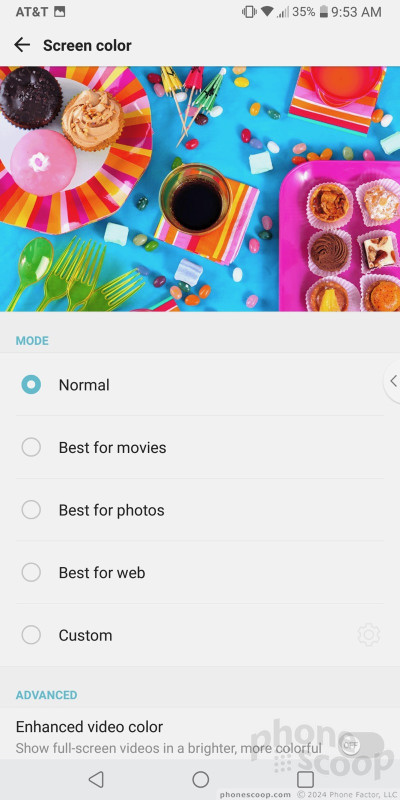









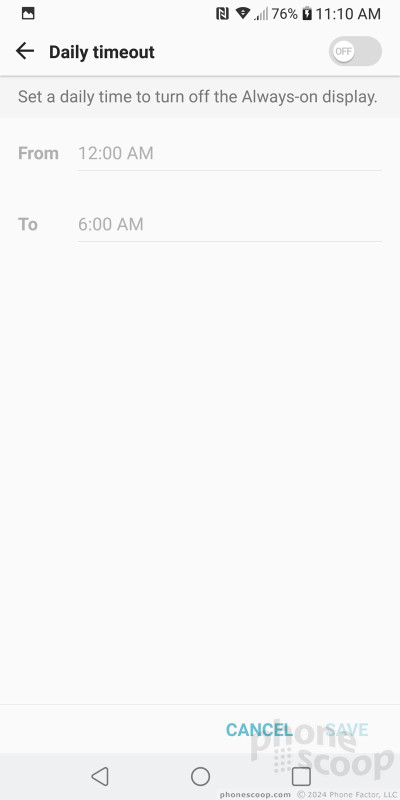
















































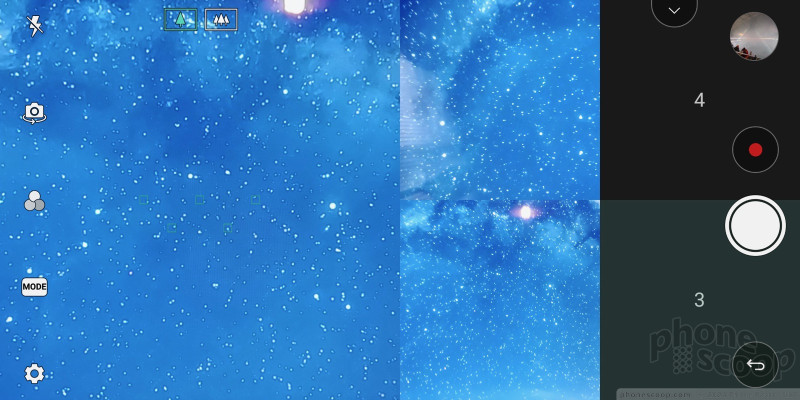




































 Best of IFA 2017
Best of IFA 2017
 Hands On with the LG V30
Hands On with the LG V30
 LG's V30S ThinQ to Cost $930
LG's V30S ThinQ to Cost $930
 AT&T's LG V30 Wins an Oreo Treat
AT&T's LG V30 Wins an Oreo Treat
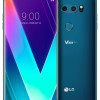 LG's V30S ThinQ Adds Color, Memory, Storage, Camera Smarts
LG's V30S ThinQ Adds Color, Memory, Storage, Camera Smarts
 LG V30
LG V30



